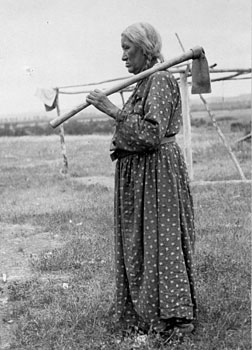
Scattered Corn with Hoe SHSND# D0566Though it would seem almost absurd in the era of the sturdy pioneer, there were at least three professional gardeners hired between 1874 and 1890 in North Dakota. The first of these was William Cannon, a horticulturist from Minnesota. Colonel Lounsberry, editor of the Bismarck Tribune, employed Cannon to work his twenty acres in the spring of 1874. Lounsberry planned to have Cannon plant 200 raspberry canes, 100 currant bushes, a “large number” of Transcendent and Hyslop crabapple trees as well as some shade trees. Though Lounsberry’s paper trumpeted the success of other gardens over the summer, there is little mention of the success or failure of his efforts by September of that year. (Bismarck Tribune, 15 April 1874)
In 1884, the Marquis de Mores, or perhaps the Marquise, hired gardener Adolph Eyraud to develop a garden for the Vallambrosa family on the banks of the Little Missouri River. Later, the Sigler Brothers of New Jersey joined the gardening staff at the Chateau. The garden was irrigated by a pump that drew water from the Little Missouri River into a ditch system in the garden. Eyraud planted seeds ordered from New York City the first year, but by 1886, “Madame de Mores” ordered seeds from Oscar H. Will & Co. of Bismarck. (Vyzralek on Medora. Documents in Appendix B)
The third professional gardener visible in the historic record was George Elliott of Chester County, Pennsylvania. A landscape gardener by profession, he came to Dakota Territory in 1879 and decided to file on a land claim near Spiritwood. Once his family was settled, Elliott established a garden to feed the men who worked on the Spiritwood Farm in exchange for having the men and equipment of the Farm plow thirty acres of Elliott’s claim.




